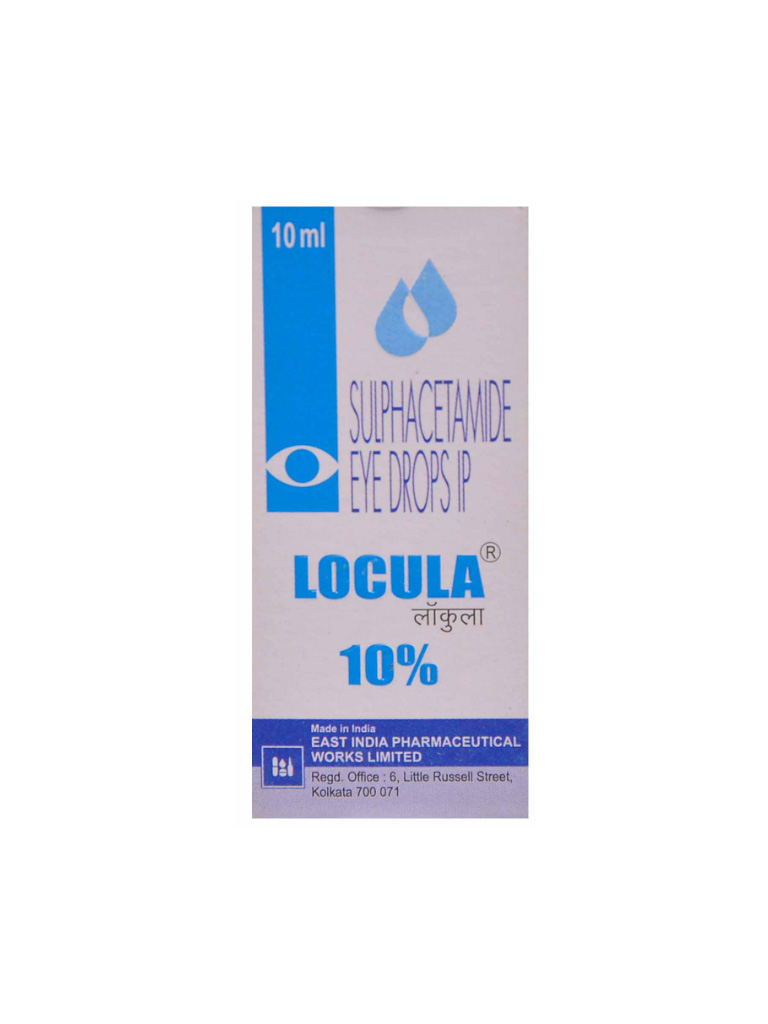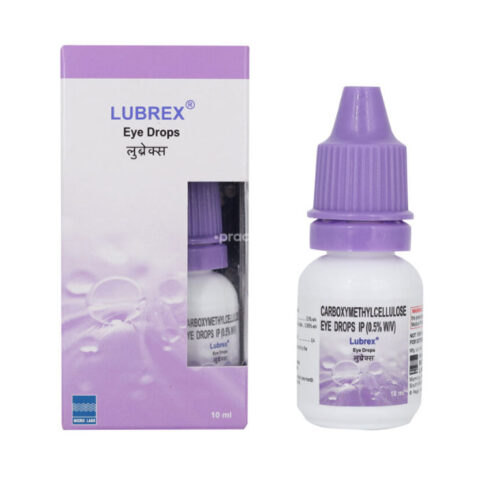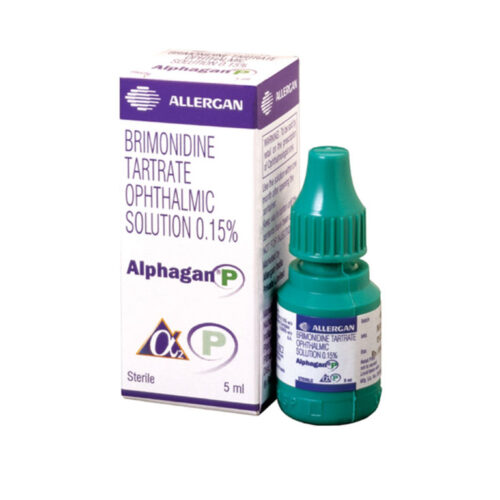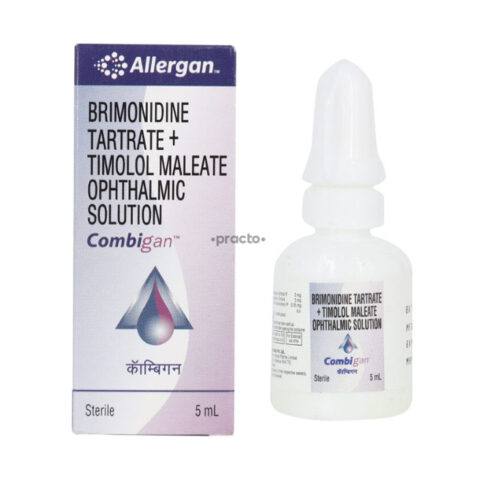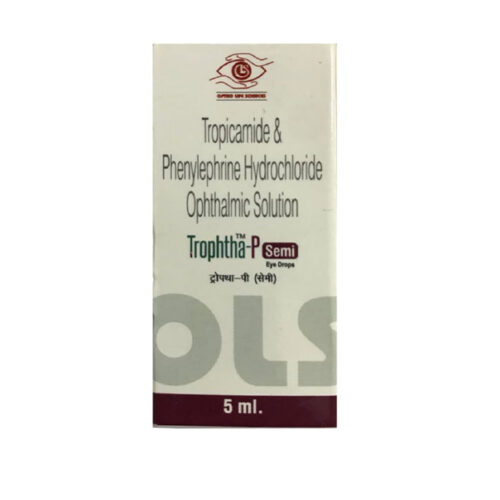Description
What is Sulfacetamide 10% / 20% / 30% Eye Drops?
Sulfacetamide is a sulfa drug that belongs to the class of medicines, known as antibiotics. It works by killing the bacteria or preventing their growth. Sulfonamides are synthetic bacteriostatic antibiotics, that are active against gram-positive and gram-negative bacteria. It blocks the synthesis of dihydrofolic acid by inhibiting the enzyme dihydropteroate synthase. It is a competitive inhibitor of bacterial para-aminobenzoic acid (PABA). PABA is required for bacterial synthesis of folic acid and it is an essential component for bacterial growth. The multiplication of bacteria is therefore inhibited by the action of sulfacetamide.
Locula® Eye Drops is an ophthalmic solution and is an antibacterial medication. The antibiotic sulfamide is the main active compound in these eye drops, and it is used to treat eye infections caused by bacteria. Locula® Eye Drops contain the sulfonamide antibiotic. It fixes the common complaint of pink eye disease.
Antibiotics are not effective against fungal or viral infections. Hence, sulfamide eye ointments will not treat eye infections caused by these microbes.
Sulfamides antibiotics work by inhibiting bacterial growth. They treat bacterial eye infections as well as prevent contamination after eye surgery or injury.
Sulfonamides are associated with relatively higher side effects than other antibiotics. Infants and pregnant women should not take sulfamides.
The long-term use of these antibiotics makes it more likely to develop infections due to other microbes like fungi and viruses.
How does Sulfacetamide Drop works?
The sulfa antibiotics work by inhibiting bacterial growth and proliferation rather than killing bacteria. The mechanisms behind its antibacterial activity depend on inhibiting an enzyme called dihydropteroate synthase (DHPS). Unlike humans, who get their folates (vitamin B9) from dietary intake, bacterias have to synthesize their own folates to survive. Bacteria use the enzyme dihydropteroate synthase (DHPS) and other chemicals (DHPP and PABA) to produce folates.
Folates are necessary for vital bacterial functions such as division and growth. The sulfamides interact with both PABA and DHPS enzymes to prevent folates synthesis.
Sulfamides have a large antibacterial spectrum, covering gram positives and gram negatives.
If a bacterial strain develops resistance to the antibiotic, there may be persistence or worsening of the infection symptoms.
Indications of Locula Eyedrops
Sulfamides have indications in both clearing the eyes of infection or preventing contamination after injury or surgery.
- Conjunctivitis or pink eye: the most common form of eye infection, it can also be caused by irritants and allergies. The conjunctiva is the moist, thin layer lining the front, white of the eyeballs, and the inner eyelids. It has a rich blood supply because it is responsible for keeping the eyes lubricated. When inflammation occurs in the conjunctiva, the blood vessels dilate, giving the eyes a pink color. Inflammation is associated with congestion and itchiness molecules such as histamines.
- Keratitis: is a lesser common form of eye infection, it involves the cornea, and it commonly affects contact lens users.
- Stye: is a red, inflammatory bump on the tip of the eyelids. A stye is an infection that occurs in the duct of a blocked eyelid gland. In adults, viruses are the microbes behind eye infections, unlike children, who commonly acquire bacterial eye infections. Before deciding the cause of eye inflammation, the doctor needs to examine the eye and take samples for lab identification of the pathogen.
How to use Sulphacetamide Eye Drops?
Before using, check this product visually for discoloration. If the product is discolored, do not use the liquid. To apply eye drops, wash your hands first. To avoid contamination, do not touch the dropper tip or let it touch your eye or any other surface. Use in the eyes only. Do not swallow or inject. Do not wear contact lenses while you are using this medicine. Sterilize contact lenses according to the manufacturer’s directions, and check with your doctor before you begin using them again.
Tilt your head back, look upward, and pull down the lower eyelid to make a pouch. Hold the dropper directly over your eye and place one drop into the pouch as directed by your doctor. Look downward, gently close your eyes, and place one finger at the corner of your eye (near the nose). Apply gentle pressure for 1 to 2 minutes before opening your eyes. This will prevent the medication from draining out. Try not to blink or rub your eye. Repeat these steps for your other eye if so directed or if your dose is for more than 1 drop. Wait several minutes for your vision to clear before driving or operating machinery. Do not rinse the dropper. Replace the dropper cap after each use.
The dosage is based on your medical condition and response to treatment. Your doctor may direct you to use this medication more often at first, then use it less frequently as the infection improves. Follow your doctor’s directions carefully. Your doctor may direct you to use sulfacetamide drops during the day and the ointment at bedtime. If you are using another kind of eye medication (such as drops or ointments), wait at least 5 minutes before applying other medications. Use eye drops before eye ointments to allow the drops to enter the eye.
Use this medication regularly in order to get the most benefit from it. To help you remember, use it at the same times each day. Continue using it for the full time prescribed, usually 7 to 10 days. Stopping the medication too soon may allow the bacteria to continue to grow, which may result in a return of the infection. Tell your doctor if your condition persists or worsens.
Side Effects of Sulfacetamide 10% / 20% / 30% Eye Drops?
Eye stinging/burning/redness and temporary blurred vision may occur. If any of these effects persist or worsen, tell your doctor or pharmacist promptly. Remember that your doctor has prescribed this medication because he or she has judged that the benefit to you is greater than the risk of side effects.
Many people using this medication do not have serious side effects. Use of this medication for prolonged or repeated periods may result in other types of eye infections, including fungal infections. Stop using this medication and contact your doctor if you notice new or worsening eye symptoms (such as pain, swelling, thick discharge, or pus).
Rarely, sulfacetamide products used in the eye may be absorbed and may cause serious side effects. Stop using this product and tell your doctor right away if any of these rare but serious side effects occur: aching/swollen joints, rash on nose and cheeks, signs of infection (such as fever, persistent sore throat), signs of anemia (such as unusual tiredness/weakness, rapid breathing, fast heartbeat), unusual bleeding/bruising, signs of liver problems (such as dark urine, yellowing eyes/skin, stomach/abdominal pain, persistent nausea, vomiting), mouth sores.
Temporary side effects: vision fogging or eye redness, stinging, or watering that occurs for a few minutes after applying the medication. These side effects are not menacing and do not require medical attention.
Persistent side effects: occur when medication leak to the body. It can cause articulation pain, joints swelling, rash in the nose or cheeks, or anemia.

